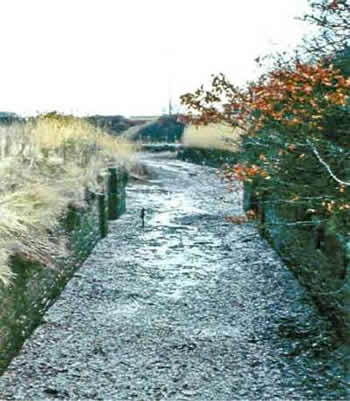
THE HACKNEY CANAL by Richard Harris |
 |
Loading barges at Newton Road Basin of Hackney Canal © Richard Harris |
HACKNEY QUAYThe importance of the hamlet of Hackney and its associated canal to the development of the ball clay industry should not be underestimated. When the ball clay deposits of south Devon were first exploited during the early 1700s most traffic in the county, including that of ball clay, went by packhorse. This meant a slow seven or eight mile journey from the pits around Preston and Bellamarsh to the nearest port of Teignmouth. Some five miles were cut from the journey by taking the clay to the tidal reaches of the Teign estuary at Hackney where storage buildings known as cellars were built. The will of Joseph Mortimer, mariner of St. Nicholas, Ringmore, made 14 May 1768 stated that he “leaves his house with furniture and stock-in-trade, viz: Ships, Boats, Lighters & Craft, to wife for life, with reversion to daughter Mary, with a moiety of the Clay Trade. He leaves his daughter Charlotte, `... my share in the new clay house at Hackney, in Kingsteignton”.
From Hackney, clay was loaded into small coasters that had made the journey up the estuary, or more usually into barges for transhipment down the river to Teignmouth where it was transferred on to waiting ships. |
 |
Map (c. 1883) showing Hackney on the Teign at Kingsteignton Courtesy of Nicholas Adams |
A study of old maps of the area show a dock inlet, now in-filled, near the site of the Passage House Inn and a series of cellars and cottages alongside the Hackney Channel. Some of the cottages are thought to have been converted from their original use as cellars, after the building of the Hackney canal in 1843. Quay walls were built at various places beside the channel to facilitate the loading of clay at high tide from the cellars into the barges. The Lords Clifford of Ugbrooke owned Hackney and the Clifford Estate papers record that as far back as 1775 a certain Joseph Pike was leasing a cellar for storage of clay there. Similarly, in 1831 a John Hatherleigh of Kingsteignton was leasing two cottages and a cellar at Hackney. The latter lease suggests that even after the opening of the Stover Canal in 1792 by James Templer, clay from the Clifford Estate lands was still being taken to Hackney for loading into barges. |
 |
An old lock on the Hackney Canal © Richard Harris |
THE HACKNEY CANAL Of the seven canals ever cut in Devon, two were created to serve the local clay trade. The smaller of these, the Hackney Canal (also known as the Kingsteignton Canal), lay entirely within the bounds of Kingsteignton parish. It was dug at the expense of a certain Henry Knight of Axminster for the conveyance of clay from the lands of Lord Clifford and opened on 17th March 1843. The canal extended for about half a mile from Hackney to its terminus beside the Newton Road where clay cellars with a storage capacity of 7,000 tons and a wharf and basin were built. Further down the canal near Hackney, a tidal lock was constructed, capable of holding two barges, commonly known as lighters. The canal basin was fed by water diverted from the Rydon stream that flows through Oakford. A sluice set in a brick built conduit controlled the inflow of water to the canal. Whilst Henry Knight enjoyed the toll revenue from the canal Lord Clifford benefited from the extra royalties earned from increased amounts of clay extracted from his lands. Records show that by 1845 Henry Knight was leasing these cellars for sixpence per annum per ton of clay stored to John Hayman Whiteway and William Roger Mortimer who were trading as Whiteway & Co and extracted clay from land off Homers Lane. During the excavation of the canal in 1842, the macabre discovery of a skeleton with a gold bracelet was made. A subsequent inquest was unable to ascertain how the unfortunate person acquired a marshland grave. |
| CONTINUED |
With the exception of the map above, the contents of this page are the copyright property of Richard Harris. |
© M.E. Brine. This page last updated
21 May, 2010
|